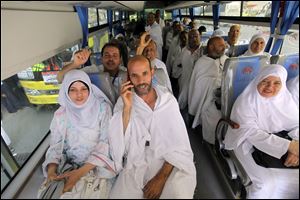
2M Muslims throng Mina for start of annual hajj
Pilgrims’ numbers reduced amid concerns over respiratory virus
10/13/2013
Egyptian pilgrims chant as they ride a bus from Mecca to Arafat, in the Muslim holy city of Mecca on Sunday. The hajj, a central pillar of Islam and one that able-bodied Muslims must make once in their lives, is a four-day spiritual cleansing based on centuries of interpretation of the traditions of Prophet Mohammad.
MECCA, Saudi Arabia — Muslims from across the world poured into a sprawling tent city in the Saudi desert Sunday before the start of the annual Islamic hajj pilgrimage, but the number of the pilgrims this year has been reduced in part by concerns over a respiratory virus centered in the Arabian peninsula.
More than 2 million pilgrims — about 1 million fewer than last year — streamed from Mecca to a huge tent encampment in Mina about three miles away to prepare for the hajj with a day of prayer and supplication.
Saudi authorities cut back on visas for groups such as the elderly, pregnant women, and those with chronic illnesses as a precaution against a new respiratory virus related to SARS that has killed more than 50 people in the kingdom this last year.
Saudi Health Minister Abdullah al-Rabiah said no cases of the coronavirus infection have been detected among pilgrims.
Further visa restrictions were imposed because of massive construction projects under way in Mecca.
The hajj, a central pillar of Islam and one that able-bodied Muslims must make once in their lives, is a four-day spiritual cleansing based on centuries of interpretation of the traditions of Prophet Mohammed.
Muslims traditionally visit the mosque where the Pro-phet Mohammed is buried in the city of Medina, and begin the hajj in Mecca with a set of rituals at the Kaaba, the cube-shaped structure in the city’s Grand Mosque that Muslims around the world face in prayer five times a day.
Muslims circle the Kaaba counterclockwise with their hearts tilted toward it.
Worshippers dress in seamless white terrycloth robes and shoes. The simple, mandatory outfit is meant to foster unity, equality, and humility.
From Mina, the pilgrims will head today to the area of Mount Arafat near a hill called Jabal al-Rahman, meaning Mountain of Mercy.
It is in Mount Arafat, about 12 miles east of Mecca, that Muslims believe the Prophet Mohammed called on people to abolish their feuds and put aside their racial, economic, and tribal differences.
Some 1,400 years later, Muslims believe on that day and at this place, the gates of heaven are open for prayers to be answered.
This year, though, some pilgrims are wearing masks as a precaution against the Middle East respiratory syndrome, which has stricken nearly 100 people, most of them in Saudi Arabia and the Middle East.
Fears of a possible outbreak among pilgrims have prompt-ed Saudi authorities to reduce each country’s quotas by 20 percent for hajj visas this year.